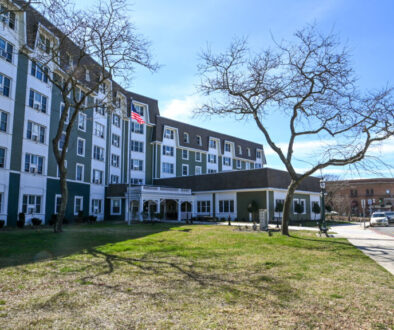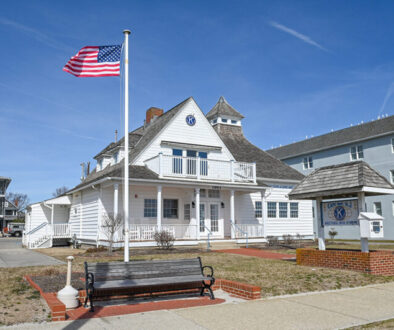Telling Tales

The tales you are about to read are all about shipwrecks, but not the Gilligan’s Island variety. These shipwrecks lie on the ocean floor, leaving histories, mysteries, tragedies, and unanswered questions. There are adventurers who search for them, solving mysteries and sometimes providing closure to the living. These are not tales about castaways. These are Cassway’s tales.
Cape May Magazine featured the Research Vessel Explorer 1.0 in a 2017 article by Jesse Piersol titled “Beneath the Emerald Current,” after some adventures with the boat called The Champion. Since then, expert diver and explorer of the sea Rustin “Rusty” Cassway, along with dive mates, made a discovery about the truth of the destiny of a ship and her crew. Not only that, Cassway launched RV Explorer 2.0 (RVX). He and his mates have had some once-in-a-lifetime adventures.
In the telling of tales, we sometimes tend to get ahead of ourselves, so before we climbed aboard Explorer 2.0, Explorer 1.0 had one final tale to be told.
The tale that takes us from Cape May to Norway

We begin on July 4th, 2018, at Utsch’s Marina in Cape May Harbor, in a slip Explorer 1.0 called home for 18 years. Following a lead and some coordinates provided by a marina neighbor, Bob Cope of Full Ahead Sport Fishing, a group of divers, Cassway, with Mike Dudas, Tom Packer, and Brian Sullivan set sail on an expedition. Explorer 1.0 headed out at dawn on one of her final quests.
As is their tradition, they turned up the volume on the sound system and blared the tune “Brandy” by Looking Glass as they exited the harbor, and entered Atlantic Ocean singing:
… “The sailors say, ‘Brandy, you’re a fine girl” (you’re a fine girl)
‘What a good wife you would be’ (such a fine girl)
‘Yeah, your eyes could steal a sailor from the sea’…”
With many laughs—and appropriate safety measures taken—they arrived at their destination, 60 miles off the coast of Ocean City, Maryland. Rusty and Brian were the first to dive. What appeared to be a sunken scallop vessel would soon be identified as a steamship, just 188 feet down. After careful underwater examination, Cassway recognized an oval-shaped object. He quickly realized what he had found: a bronze builder’s plaque with the words “Nylands Verkstead, 1938 Oslo.” His hands were the first to hold this plaque since the builder placed it on the ship. Explorer returned to Utsch’s Marina with the team of divers bursting with excitement.
The ever-resourceful Cassway knew exactly who could help him learn the identification of this ship, but due to the language barrier, he needed help from the Maritime Museum in Oslo, Norway. Cassway called an old friend, Huldrun Somers, with whom he previously worked in a diving shop back in the 1980s. Cassway knew she lived in Oslo, and with her assistance, the museum confirmed the discovery of the D/S Octavian.
The tale turns into a mystery. According to historic records, the Octavian went down off the coast of Newfoundland. How could it be that an entire crew of Norwegian merchant mariners sank to the bottom of the Atlantic Ocean off the coast of Maryland in 1942, but for 76 years, the loved ones of this crew believed they perished off the coast of Canada? What caused the ship to sink, and when? Most importantly, why the mixup on the location for all these years? With experts like shipwreck historian Gary Gentile and wreck diver Mike Dudas, the truth was uncovered.


That truth was that the Octavian had been torpedoed by a German U-123. They even got the name of the Nazi commander who shot them down: Reinhard Hardegen, who died at age 105, less than a month before Cassway and crew confirmed when they identified the wreck. They found the true location, the final resting place, where a Norwegian merchant ship went down in the cold winter Atlantic, not off the coast of Canada, but the shores of Maryland on January 27, 1942.
Cassway took this to the next level, providing a sense of closure to the families of those lost on that day. On May 8th, 2019, the anniversary of Norway’s liberation from the Nazis in 1945, Cassway and his dive team, Dudas, Liberty Jay, Tom and Kim Packer, Tim Terrey, John Copeland, David Fisher, and Gary Gentile made a personal delivery to Norway, and handed over the polished brass plaque. Eighty-seven descendants of the Octavian’s fallen attended a ceremony at the museum. Cassway and his team were honored and moved to deliver this closure to loved ones, and the plaque is now permanently on display at the Maritime Museum in Oslo.

After the ceremony, Thelma Dahl, great-granddaughter of the man at the helm of the Octavian, Captain Jans Dahl, approached the Cape May team to thank them. Realizing that she was a close descendant of the ship’s captain, Tim Terrey later shipped her something very meaningful. He salvaged the helm of the Octavian, the very helm that her great grandfather held as he navigated this vessel during a Nazi attack. “We must show respect for those lost at sea, and remember this on every dive,” Cassway said. “Returning the plaque to Norway and meeting the descendants has more intrinsic value than a bronze plaque hanging on your own wall.”
Rusty Cassway wears a shirt that says, “Nobody owns the ocean.” He lives by that philosophy. “The ocean and the ships we dive belong to everyone and they are there for everyone to enjoy, whether they’re diving or fishing. The real joy of it all comes from sharing and collaborating with other passionate individuals.”
The tale of a sale and a concept brought to reality
Explorer 1.0 was sold to Will Hinton, owner of Nautical Divers in Jacksonville, Florida where the diving adventures continue to this day.
Cassway and his mates will never forget the epic adventures aboard her. She always returned them safely home to Cape May Harbor, and would carry the memories with her of the Octavian, Champion, and countless good times with friends and family.
Cassway visited her in February.
“I’m so happy that the epic diving adventures are continuing on her,” he said.
Onward!
Fueled by passion and dreams of future adventures, Cassway conceptualized a new dive boat, RV Explorer 2.0. “I had a vision of the boat, and nobody to execute it,” he said. “But the Cape May connections came together.” After a conversation with local master welder David Burkhardt of Burkhardt Welding, Cassway connected with Cape May natives Eric Berg and Mike Tilsner, who had just founded the first shipbuilding company in southern New Jersey in decades, Delaware Bay Shipbuilding, in Leesburg. “It was a match made in heaven! I wanted to build a boat and they wanted to build one. Explorer 2.0 was their first boat,” explained Cassway.
Naval architects used the latest in design technology, and the Explorer 2.0 design phase began. From concept to execution, getting the new Explorer on the water took two years. You can see a time-lapse video of the boat assembly process at explorercapemay.com. Explorer was christened in Dorchester in June 2022. Next, she made her way to her home slip back in Utsch’s Marina.
Explorer has an official mission statement: “The RV Explorer dive vessel is designed to bring together great people for the purpose of exploring shipwrecks of the sea. Next to safety, having fun is our top priority. Whether you are a new diver on your first ocean dive or an experienced tech diver, the goal is to have fun.”
Cassway ensures that everyone aboard Explorer is keenly aware of these core values.
- Safety First
- Always Do the Right Thing
- Be a Team Player
- Grow Yourself and Others
- Celebrate Diversity
- Respect Yourself and Others
The tale of tails
In the spirit of fun and keeping with the mission of Explorer, when those aboard start an expedition, their primary goal is always the same: spot tails, but not of whales or other common creatures of the sea. They are searching for mythical mystical mermaid tails, and the slogan “Mermaids mostly!” is a refrain onboard. It’s in their quest to find the mythical creatures that they are always taken on other adventures and to make other discoveries during their quest. Have any mermaid sightings occurred to date? “We’ve had reports, but no confirmations,” Cassway regretfully admitted.
Searches for mystical tails in the sea often create a media buzz. Besides being highlighted here at Cape May Magazine and WCFA 101.5 FM Cape May Radio, they’ve got the attention from media outlets like National Geographic, The History Channel, The New York Times, and others.
The tale of a fateful submarine
It was a particularly cold January in 2021. As Cassway patiently awaited the completion of Explorer 2.0, he received an email from Gary Gentile, who had been researching a long-lost German submarine U-boat, the U-111. He had an idea about the location and urged Rusty to “investigate that site as soon as possible.” Even before the boat was finished, Cassway already had its first adventure on tap. The extra time gave the team the luxury to do some recon. This time they dove into data and technology.
Some background information: After World War I, the Germans surrendered their fleet of submarines (U-boats) to England because of the Treaty of Versailles. But why would U-111 be found so close to the east coast of the U.S.? Here’s why: The Navy piloted the vessel back from England to the U.S. to reverse engineer it as a weapon of war, to analyze it, and to gain more intelligence on the enemy.




The U-111 was originally thought to be in much deeper water. Further, it was one of the last sunken submarines that had yet to be discovered. Unlike so many shipwrecks throughout history, this ship went down with absolutely zero casualties. The Navy eventually scuttled (purposely sunk) the U-111, but the recorded location was wrong. This vessel was reported to be sunk in deeper waters, waters believed to be beyond an underwater cliff, or shelf, yet it did not sink beyond that shelf to the deepest depths.
Many shipwrecks are discovered by commercial fishing vessels. Huge fishing nets and scallop dredges get hung up on these wrecks and ruin the day for a fishing crew. They mark these spots, so that these “hangs” don’t happen to anyone else. Wreck divers use this data to identify potential discoveries.
During the planning for the first expedition on the new boat, researcher and primary dive team member Ross Baxter developed a partnership with Remote Operated Vehicle (ROV) manufacturing company, Blue Robotics, a best-in-class ROV for use in depths up to 1000 feet. Rusty’s team nicknamed theirs “BART,” after the late diving legend, Bart Malone.
Explorer was completed, and in spring of 2022, the team was armed with the ROV and the training and skills to perform their first deep-water survey using BART. The date was June 21, 2022, and the expedition team consisted of Cassway, Ross Baxter, Eric Petkovic, John and Michael Haws, Dan Quinlin, Gary Gentile, John Copeland, and Jim Walsh. With the team’s additional research, finding the wreck was efficient as could be. It was located immediately, and a grapnel was dropped 400 feet to snag the wreck. So far, so good, except that there was a ripping current, but the team engineered a weighted leash prior to deploying the ROV. With luck on their side, the anchor landed next to the conning tower of the submarine. According to Cassway’s dive journal, “As Ross piloted the ROV, features of the submarine from historic photos were compared to the live video stream by Eric and Gary. There was no doubt that this wreck was the remnants of the long-lost U-111.” Explorer 2.0 made her way back home and was tucked again safely into her slip in Utsch’s Marina, with the team of giddy explorers, who knew the importance of what they had just identified.
On Labor Day, 2022, a team from National Geographic boarded Explorer for a replication of the June discovery. “What the RV Explorer team did was, through hard work, technology, research, and teamwork, discover that this wreck was the final resting place of the long-lost U-111,” Cassway states. Following the core values of the RVX, a humble admission followed that it took a multi-generational team that incorporated the perfect combination of passion, skills, research, and knowledge to make this discovery.
The tale of the disintegrated box of treasures

True story. Recently, Cassway had plans to bring Explorer 2.0 to Florida in the winter of 2024 for a few different projects, including a meetup with the original Explorer 1.0. “It was a full circle moment,” said Cassway. Both boats had their own teams, and they met up for a diving expedition together, diving the wreck of the SS Peconic, an American cargo ship that foundered in a storm in 1905, taking 20 souls with her.
The divers found treasure this time! It was a wooden box, found in the captain’s stateroom measuring approximately 8” x 5.” When touched, it disintegrated, revealing its contents: gold and diamond rings and silver coins. “I kid you not! It was epic!” insisted Cassway, who witnessed this.
A tale, starring you…

All these tales begin with a boat leaving Cape May Harbor, often blaring “Brandy.” And there are more. Cassway posts them at explorercapemay.com, along with photos, videos, and information on how you can climb aboard the Explorer. Cassway and his crew offer this opportunity and promise to provide adventure on and under the water. The Explorer offers diving charters and even sunset cruises, whether it’s to find a sunken ship, treasures in the deep, or discovering the world’s most perfect sunset on the Delaware Bay.
You may even capture a glimpse of the mystical mermaid.



